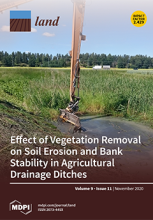/ library resources
Showing items 1 through 9 of 125.In this study, a knowledge-based fuzzy classification method was used to classify possible soil-landforms in urban areas based on analysis of morphometric parameters (terrain attributes) derived from digital elevation models (DEMs).
The recent decades have witnessed a significant increase in the population in peri-urban areas which led to a progressive transformation of peri-urban landscapes, and the reduced ability of agriculture to provide ecosystem services.
Drastic growth of urban populations has caused expansion of peri-urban areas—the transitional zone between a city and its hinterland.
Street trees, native plantings, bioswales, and other forms of green infrastructure alleviate urban air and water pollution, diminish flooding vulnerability, support pollinators, and provide other benefits critical to human well-being.
The contemporary urbanization and its implication to land use dynamics especially in the peri-urban areas are emerging as a cross-cutting theme in policy debates and scientific discourse.
The purpose of this research is to better conserve biodiversity by improving land allocation modeling software. Here we introduce a planning support framework designed to be understood by and useful to land managers, stakeholders, and other decision-makers.
Nowadays, urban sprawl, urban densification, housing shortages, and land scarcity are some problems that intervene in the practice of urban planning. Those specific problems are currently more than ever emergent because they imply the notion of spatial justice and socio-spatial inequalities.
Alpine pastures and meadows are agroecosystems of biological, cultural-historical, and economic importance that are undergoing profound imbalances and which are in a rapid decline due to changes in management and/or abandonment.
The cadastral system is a land management and land administration tool to provide a safe and reliable real property registration system.
Paginación
Land Library Search
Through our robust search engine, you can search for any item of the over 73,000 highly curated resources in the Land Library.
If you would like to find an overview of what is possible, feel free to peruse the Search Guide.




